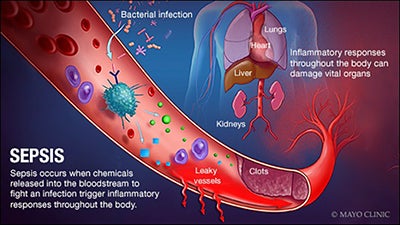Consider T.I.M.E. when dealing with a sepsis diagnosis
Published 8:38 pm Friday, March 15, 2024

- Melissa Myers, M.D.
|
Getting your Trinity Audio player ready...
|
Austin Daily Herald
newsroom@austindailyherald.com
Nearly 270,000 people in the U.S. die annually because of sepsis — more than the number of people who die from prostate cancer, breast cancer and AIDS combined. Yet more than 40% of adults are unfamiliar with the danger of sepsis.
“Sepsis occurs from an infection and can quickly become life-threatening,” says Melissa Myers, M.D., a critical care specialist in Intensive Care at Mayo Clinic Health System. “When your body has an infection, the natural response is for the immune system to fight the infection. If the body creates too much of a response to the infection, inflammation can develop, triggering sepsis.”
What’s concerning is any type of infection that occurs anywhere in the body can lead to sepsis.
Infections that lead to sepsis most commonly occur in these parts of the body:
• Bladder and urinary tract
• Gallbladder and biliary tract, which includes organs and ducts that make and store bile
• Lungs
• Skin
• Soft tissues like fat or muscles
“There is a myth that only people who have been hospitalized are at risk of developing sepsis,” Myers said. “In fact, 87% of cases originate outside of the hospital setting. Another myth is that sepsis is rare and only affects people with preexisting conditions.”
Myers says anyone can develop sepsis, but those at a higher risk are:
• Adults 65 or older
• Children under 12 months
• People with weakened immune systems
• People with chronic medical conditions, such as diabetes, lung disease, cancer and kidney disease
• People who have had a recent hospitalization
• People who previously have had sepsis

Sepsis. Asset created for Mayo Clinic News Network (MCNN)
Pericles once wrote that “time is the wisest counselor of all.” When it comes to sepsis, the acronym T.I.M.E. is the wisest counselor when it comes to recognizing and remembering the signs and symptoms of sepsis. The acronym is:
• T: temperature — higher or lower than normal
• I: Infection — signs and symptoms of an infection
• M: Mental decline — sleepy, difficult to rouse, confused
• E: Extremely ill — severe pain, discomfort, shortness of breath
“Suspected sepsis should be handled as an emergency by calling 911 and going to a hospital, like you would do with a suspected heart attack or stroke. Urgent response and rapid, aggressive treatment increase the rate of survival,” explains Myers.
Symptoms of early sepsis can appear similar to other conditions and survival depends on pinpointing the source of infection. Blood and urine tests and imaging scans may be used to help identify the type and location of infection.
According to Myers, people at risk of sepsis or who previously have had sepsis should be proactive in talking with their healthcare team about the possibility of sepsis when they are feeling ill.
“Treating sepsis as early as possible is crucial to prevent it from worsening,” offers Myers. “Determining where the infection is and eliminating it is vital to keeping sepsis from progressing to severe sepsis or septic shock. Even with treatment, sepsis can progress to severe sepsis or septic shock causing organ damage.”
Myers says close monitoring and treatment for sepsis takes place in the hospital setting, typically with a combination of:
• Antibiotics
• Intravenous fluids
• Other medications, which may include vasopressors, corticosteroids or pain relievers
• Supportive therapy, such as oxygen, kidney dialysis or mechanical ventilation
• Surgery, which may be needed to drain or remove the infection
“Many people who recover from sepsis return to the same level of activity they had before their bout with sepsis. Some people, especially those with weakened immune systems or chronic illnesses, may experience long-term effects,” says Myers.
Talk with your primary care provider to determine if you’re at increased risk of developing sepsis.
There are several steps patients can do help reduce the risk of sepsis says Myers. They include doing the following:
• Prevent infections.
• If you have chronic conditions, follow your healthcare provider’s directions to manage the conditions. Get recommended vaccines.
• Practice good hygiene.
• Wash your hands regularly with soap and water or an alcohol-based hand sanitizer. Clean and cover cuts until they’re entirely healed.
• Know the signs and symptoms.
• Temperature, infection, mental decline and an extremely ill feeling — T.I.M.E.— are reasons to suspect sepsis and get help fast.




